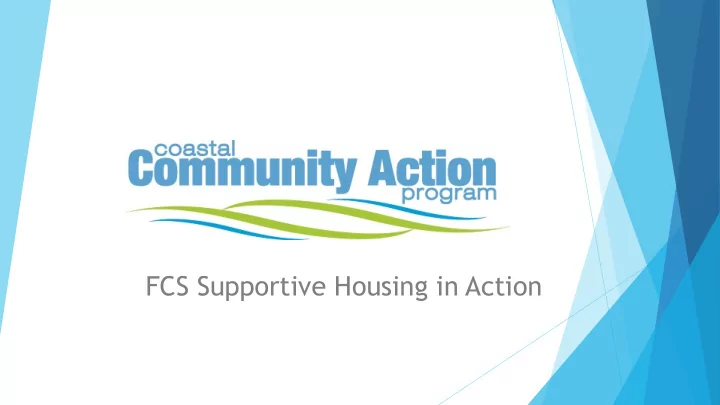

FCS Supportive Housing in Action
Benefits Serve More Clients – Over 400 FCS Authorized Clients – Every client who asks u for support services is assigned a care coordinator. Lower Case Manager to Client Caseloads (Added 20+ new full-time staff) u More Holistic Approach (focus on wellness and health care) - Helping Clients u Reach Self-Sufficiency
Step by Step u Coordinated Entry u Authorization / Assign to a Case Manager u All clients enrolled in Pathways u Individualized Assessment / Develop a Stability Plan (evidenced based) / Self Sufficiency Matrix u Care Coordination / Make Connections u Monitor Progress (Self Sufficiency Matrix) u Report Outcomes
Self-Sufficiency Matrix Integrated into our Individual Assessments u Crisis, Vulnerable, Safe, Stable, Thriving u Case Management Tool to Identify Level of Service and Document Client u Progress Self-Assessment Tool to help clients understand where they are and where u they would like to focus their time and energy Communication Tool to demonstrate success, identify key barriers, and u demonstrate what is and is not working
Braiding Funds FCS authorized clients are co-enrolled in all our rental assistance programs u FCS funds supplement (enhance) existing resources. We do not separate FCS u authorized clients by assigning them to a different care coordinator. Every client receives services based on their individual assessment needs and u wiliness to engage in services. FCS clients are not treated differently from non-FCS authorized clients. Use FCS funds to hire more staff to lower caseloads and provide more u appropriate level service – Most vulnerable populations Pathways allows us to utilize an evidenced-based service model. Pathways u incentivizes client outcomes.
Pathways We are asked to work with the most vulnerable clients. This requires more u intensive case management services. We serve all our clients using Pathways as our case management framework. Our previous case management approach was very theory based. We identify u these principles as the “What” we should be doing. Examples: Housing First, Progressive Engagement, Motivational Interviewing, Find-Pay-Stay etc. Pathways (CCS system and tools) gives the “How” u For example: Individualized Assessments – we know we need to do them but u we lacked the proper tool to do them well. Pathways is labor intensive. In exchange, we are incentivized for using u evidenced-based tools which have significantly improved the quality of our services.
October 2019 Incentive Earnings We earned $48,752 from outcome based payments from 8/01 – 9/30 u Examples of payments: Adult Checklist $33 to $44 based on risk of client, u Behavioral Health Referral $44 to $55, Employment $44, Health Insurance $55 to $65, Medical Home $55, Medication Management $110, Social Service Referral $22 to $33, PHQ-9 $33 Payments are based on what clients complete with our assistance. We document completion of outcomes in the CCS system, they reviewed and verified and then submitted for payment.
Braiding Funding Sources Access for All Clients Seeking Services Grant Housing Subsidies • (HEN,CHG,TBRA,HUD) FCS for Pre-Post Housing • Support Services (Fee for Comprehensive/Holistic Support Services Service) Pathways • (Performance/Incentive Funding) Adequate Resources Quality Supportive Housing Services that Transform Lives
Budget – Time Allocation Ø One Case Manager Ø Caseload of 25 - 30 Ø 1-year of Service (60 units) Ø $150,000+ available in fee for service reimbursements --------------------------------------------------------------------------------------- Ø 80 - 100 units per case manager = $8,400 to $10,500 per month Ø Average caseload 16 to 20 “active” clients Ø A minimum of 60% of a full-time case manager’s time should be “billable” Ø 160 hours in a month @ 60% is 96 units Ø Frequency of service is connected to self-sufficiency domain
Our Challenges u Timely Verification u Too Many Denials u New Client Issues u More Interdependent on Community Partners u Leads to Teams u Expensive u Accountability Tension u Demand Exceeds Capacity u Failing Forward is Taxing – Positive Restlessness
Jason Hoseney Director, Housing and Community Questions Services jasonh@coastalcap.org 360.589.9094
Recommend
More recommend